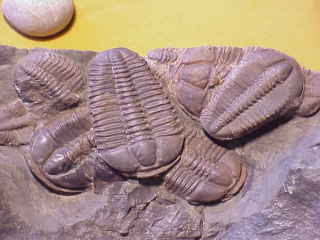Trilobites
Prehistoric oceans were populated by large numbers of primitive arthropods known as trilobites. Judging from the fossil record, these creatures may have been among the first arthopods to inhabit the earth. Well-developed fossil trilobites first appear in rocks formed nearly 600 million years ago during the early Cambrian period. Descendents of these ancient trilobites spread throughout all of the earth’s oceans and then, near the end of the Permian period (about 225 million years ago), they rather suddenly became extinct.

All we know about the trilobites has been deduced from their fossils. Paleontologists have found over 4000 different “species,” ranging in size from 6 mm to more than 60 cm in length. Their bodies were multisegmented, covered with an exoskeleton, and divided by longitudinal grooves into a median lobe and two lateral lobes. The body was also divided into three functional regions: a head, a thorax, and a pygidium (tail). Compound eyes and slender antennae were often present on the head, and most body segments (including those of the head and pygidium) bore at least one pair of jointed appendages. In some species the appendages were branched: one part was leg-like (probably used for crawling or digging), the other part was feathery (perhaps forming a gill or a paddle for swimming). Appendages near the head were usually unbranched and may have served as mouthparts.
Most trilobites lived in the mud of shallow marine environments where they fed as predators or scavengers on a variety of organic material. Some species may have been able to swim or float, while others probably lived on or under rocks. Most trilobites could curl their body into a ball, and like pillbugs and sowbugs of today, this posture was probably a form of defensive behavior.
 No one knows exactly why trilobites became extinct. Their demise seems to coincide with a massive wave of extinction that claimed more than 90% of all marine species at the end of the Permian period. The most popular explanation, a global change in climate, is supported by evidence of sudden changes in sea level and terrestrial vegetation. The swamp-like forests of horsetails, club mosses, and seed ferns died out and were replaced by cycads and other primitive seed-bearing plants. Dust clouds from excessive volcanic activity, the impact of a comet or meteorite, or the gravitational pull from the near-miss of a large celestial body have all been suggested as possible explanations for the great Permian extinction.
No one knows exactly why trilobites became extinct. Their demise seems to coincide with a massive wave of extinction that claimed more than 90% of all marine species at the end of the Permian period. The most popular explanation, a global change in climate, is supported by evidence of sudden changes in sea level and terrestrial vegetation. The swamp-like forests of horsetails, club mosses, and seed ferns died out and were replaced by cycads and other primitive seed-bearing plants. Dust clouds from excessive volcanic activity, the impact of a comet or meteorite, or the gravitational pull from the near-miss of a large celestial body have all been suggested as possible explanations for the great Permian extinction.

